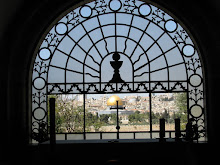On behalf of the Midrasha hike club there was an effort to see flowers in the Negev desert. To be more specific, the region we hiked is called Lahav forest (14 km from Beer Sheva). Lahav is one of the biggest planted (man made) forest in Israel. I was the only person from Sde Boker campus who joined the hike! However, around 20 people (from different locations near our campus) participated in this effort. Most of them were aged 50+ and to my surprise some women were even 80+. We flagged off by early 6 in the morning and reached there by 7.30 am. To me at least, it was difficult to call such lush green area a desert! May be that’s what people mean by the phrase ‘Jews made desert bloom’!
The total distance covered by walk was approximately 12 km and that took us through many ancient sites, some dated even from 6th century BC. Apart from widely scattered dark red Anemone flowers (Klemantina in Hebrew) in the valleys, many unique plants were also observed that had Biblical significance. Although, the guide who took us to the trip explained everything in Hebrew; me being the only outsider, some of the participants took serious initiative to translate everything they could into English so that I should not be left bored. There were experts in botany, entomology, geology and history among the group, so everyone contributed their expertise to the trip. In short, I had a 12 hr outing to celebrate the Sabbath and it was evening 6 when I was back.
A brief note into the places we visited in the Lahav area.
Lahav Forest
Lahav forest covers more than 6,750 acres. All the pine trees you see here are planted by Israeli organization called Keren Kayemeth Le’Israel - Jewish National Fund (KKL-JNF) from 1952 onwards. The beauty is that you see a green belt against the background of a desert area which hardly receives 300 mm rainfall in a year.
The total distance covered by walk was approximately 12 km and that took us through many ancient sites, some dated even from 6th century BC. Apart from widely scattered dark red Anemone flowers (Klemantina in Hebrew) in the valleys, many unique plants were also observed that had Biblical significance. Although, the guide who took us to the trip explained everything in Hebrew; me being the only outsider, some of the participants took serious initiative to translate everything they could into English so that I should not be left bored. There were experts in botany, entomology, geology and history among the group, so everyone contributed their expertise to the trip. In short, I had a 12 hr outing to celebrate the Sabbath and it was evening 6 when I was back.
A brief note into the places we visited in the Lahav area.
Lahav Forest
Lahav forest covers more than 6,750 acres. All the pine trees you see here are planted by Israeli organization called Keren Kayemeth Le’Israel - Jewish National Fund (KKL-JNF) from 1952 onwards. The beauty is that you see a green belt against the background of a desert area which hardly receives 300 mm rainfall in a year.
A few words about Israel’s reforestation initiatives….. The world's largest reforestation effort is made in Israel. Israel is probably the only country in the world that entered the 21st century with a gain of trees. There is a Jewish festival celebrated every year called “Tu Bishvat” in which there is a custom to plant trees. Today, any one interested to plant a tree in Israel is encouraged by the Jewish National Fund. JNF will plant the requested number of trees on his/her behalf through a donation (the current rate is 18$/tree). In return the concerned person will be issued a certificate in his/her name with all the details.
Ancient Ruins in Lahav
Hurvat Za’ac
One can see a series of caves and water storage structures among these ruins. These caves were inhabited by the Bedouins till Israel was formed in 1948. Much before the Bedouins, these caves were believed to be used by Jewish people from the 2nd and 3rd centuries. There is also a well seen down the settlement, thought to be from the Biblical periods.
Hurvat Abu Hof
The ruins contain remains of a settlement from the Byzantine period including two churches from the 6th and 7th centuries AD, whose pillars can still be seen in this site laid on the ground. The southern church had an underground room which probably held a sacred artifact.
Hurvat Rimon (Rimmon in Hebrew means Pomegranate)
Located in the edge of Lahav forest about half a kilometer south of Kibbutz Lahav. Upon a hill (1500 ft) lie the ruins of this ancient settlement (spread over about 25 acres) including many caves. It is believed that this site is the location of Biblical Ein Rimon (Nehemiah 11:29). Ein Rimon was home to the few Jews who were not expelled to Babylon during the destruction of first temple (587 BC).
An ancient synagogue (from the time of the Second Temple, 1st Cent AD) is the most impressive structure excavated from this site. On the synagogue’s floor one can see five rosettes (typical of the time of the Second Temple) with six petals and a seven-branched menorah in each rosette. Near the synagogue area archaeologists have found 2 pieces of pottery which together held 47 gold coins from the 4th and 5th centuries. The remains of many ancient Jewish homes and graves still exist in the area of the Rimmon ruins.
http://www.ynet.co.il/english/articles/0,7340,L-3386689,00.html










































